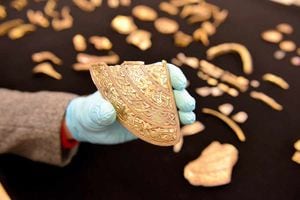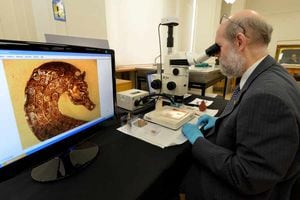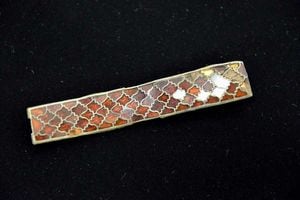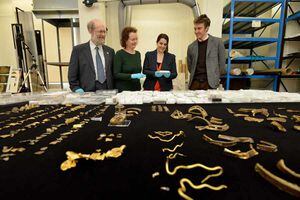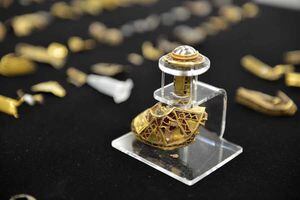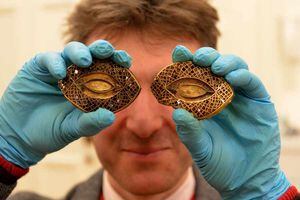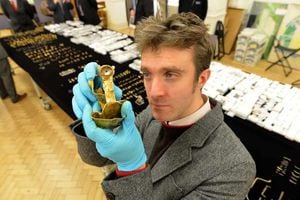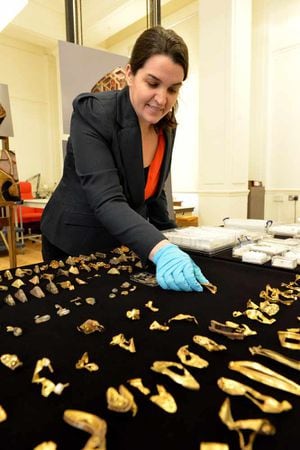Famous Staffordshire Hoard is put together for first time at Birmingham museum
It started with a solitary man with a metal detector. He made an astonishing discovery that unlocked a fascinating story of kings, warriors and religion that has gripped the world.
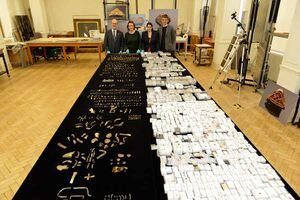
And now some of the mysteries of the Staffordshire Hoard have taken a new twist as the incredible find – the biggest of its kind – has started to rewrite the history books.
These pictures show the entire, fully-cleaned Hoard photographed in one place for the first time since its discovery in 2009.
For two weeks the 4,000-piece collection has been brought together in a back room at Birmingham Museum and Art Gallery so experts could start a major study to group items and make links between each fragment like an ancient jigsaw puzzle.
It is a scene witnessed by fewer than 200 people and one that it is predicted may never happen again. The findings are staggering and shine fresh light into the depths of what are known as the Dark Ages.
Hundreds of connections have been found, revealing at least one helmet made up of over 1,500 fragments.
Anglo-Saxon helmets are incredibly rare with only five previously found in Britain.
The research has also confirmed there are up to 150 swords, which represents an extraordinary haul of warrior kit. It has also revealed for the first time the true extent of gold wealth across the kingdoms – much greater than ever envisaged before.
Anglo-Saxon specialist Chris Fern has spent 18 months examining each item in the collection individually.
But to complete his analysis it became clear all the items would have to be brought together to complete the grouping exercise.
So they were all packed up and in total secrecy, experts carried out the work over two weeks in the depths of the museum. Mr Fern revealed: "The Hoard is not a monolith, it's a very complex find which points to multiple origins and is very significant for understanding the true material culture of the early kingdoms of Anglo-Saxon England.
"The finds are the style and substance of early England in a way we have never seen before. The sort of wealth that was alluded to in the Anglo-Saxon poem Beowulf, previously believed to have been a great artistic exaggeration, has now been mirrored in archaeology. It suggests that the warrior elites shared in the sort of gold wealth enjoyed by kings and royalty. We don't yet have all the answers but we have reached a milestone in conservation and research."
Mr Fern said items in the Hoard were shown to have origins from three kingdoms: Mercia, East Anglia and Northumbria.
The items span up to 150 years over the turn of the 6th and 7th centuries made up of 11lbs (5kg) of gold, 3lbs (1.3kg) of silver, plus garnet and Roman glass.
It has a value in excess of £3 million. And now the three-year conservation and clean-up is complete, the full extent of decoration, quality, iconography and workmanship has been appreciated.
Among the collection are more than 80 pommel caps – the decorative tip of a sword – where previously only 20 had been discovered in England.
The intrinsic craftsmanship of Anglo-Saxon filigree of tiny gold and silver beads or twisted threads can also be truly admired and studied at close quarters for the first time.
David Symons, curator at Birmingham Museum, said: "The Hoard makes up something like 60 per cent of all Anglo-Saxon filigree discovered.
"This is unique. Nothing like it has been found before in this scale. It is mind-boggling."
On one pommel cap, Mr Symons thinks he can make out part of confronting lions, which would show an influence from the Mediterranean.
It is already believed some of the garnet discovered could have come from India and Sri Lanka.
